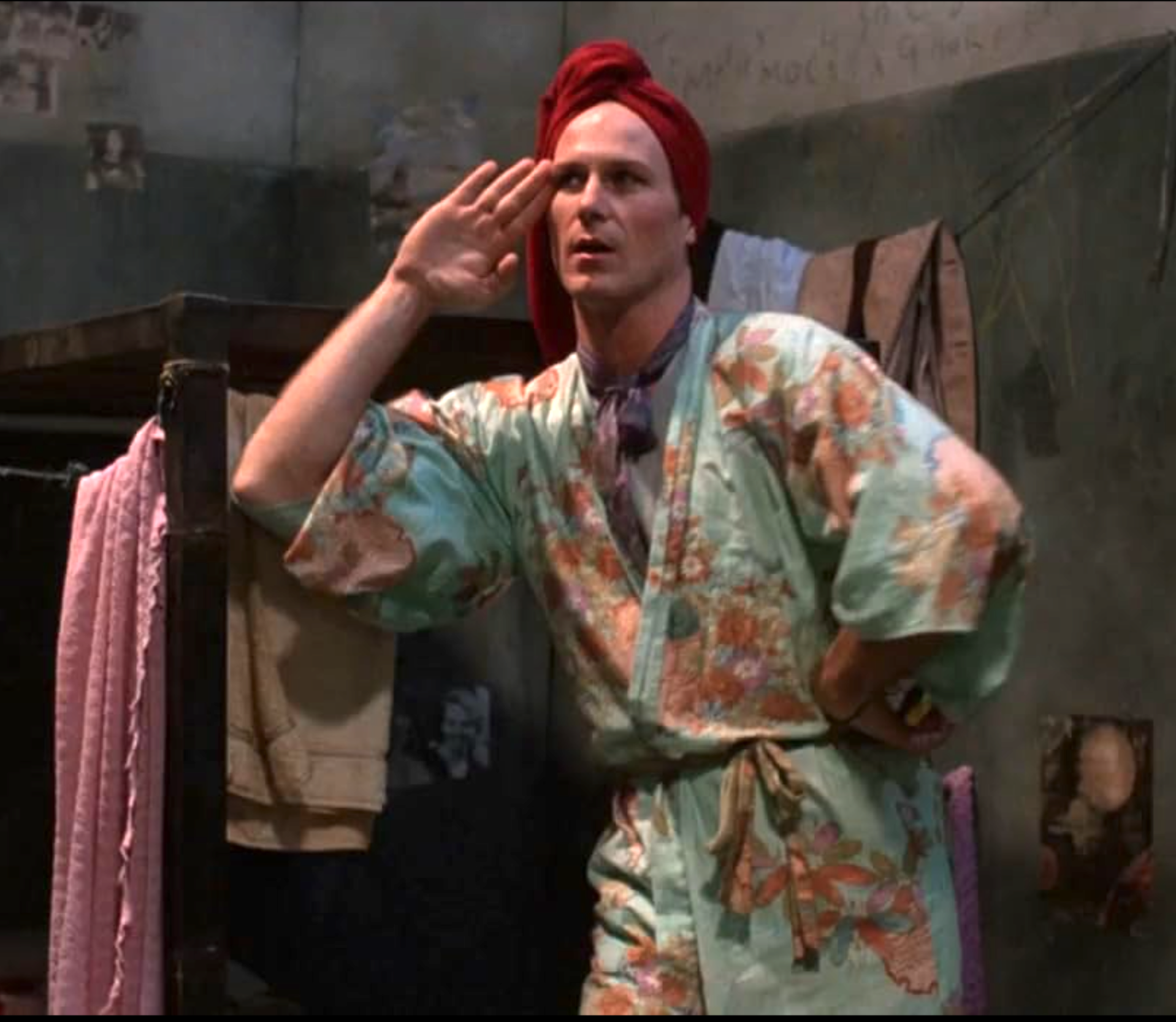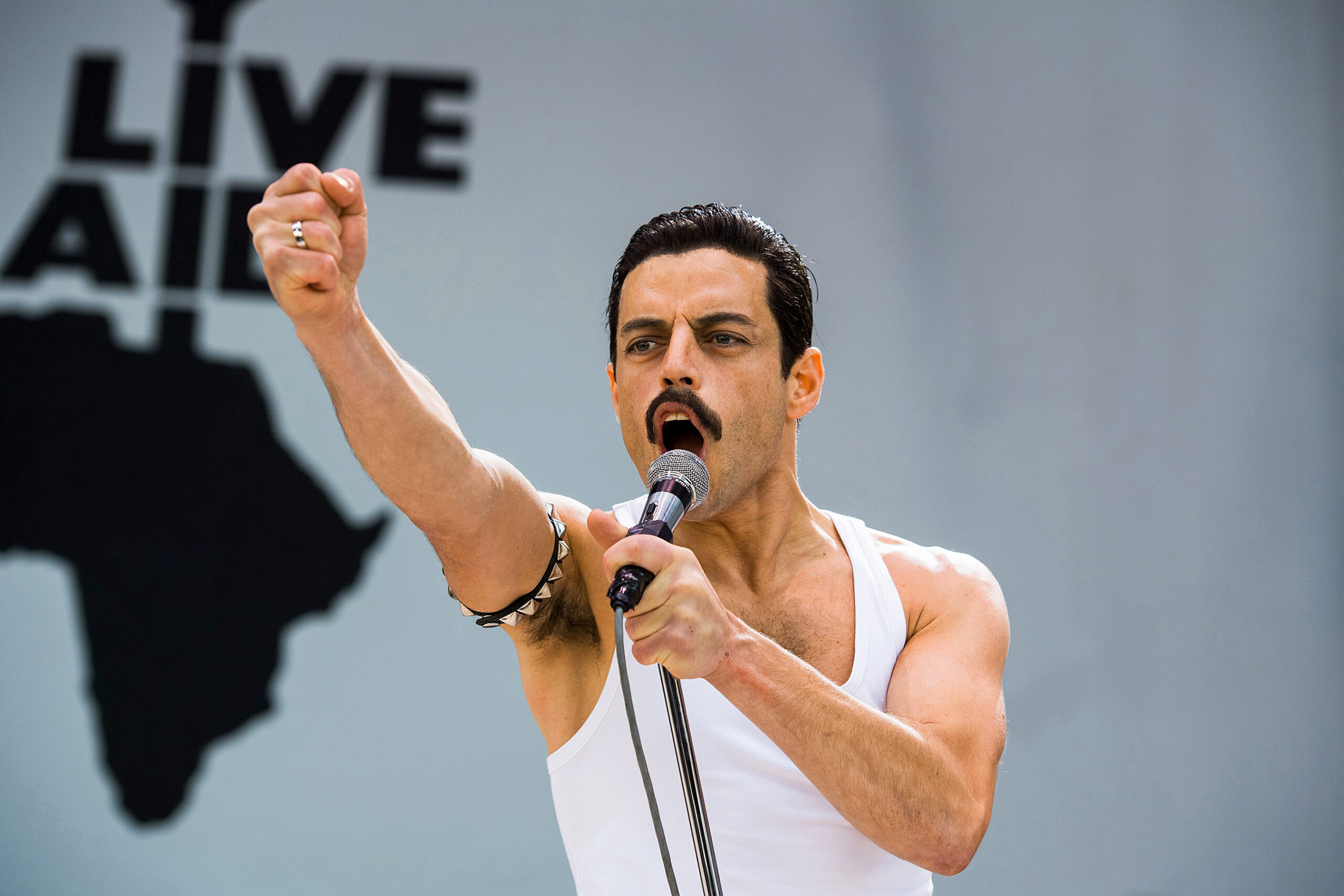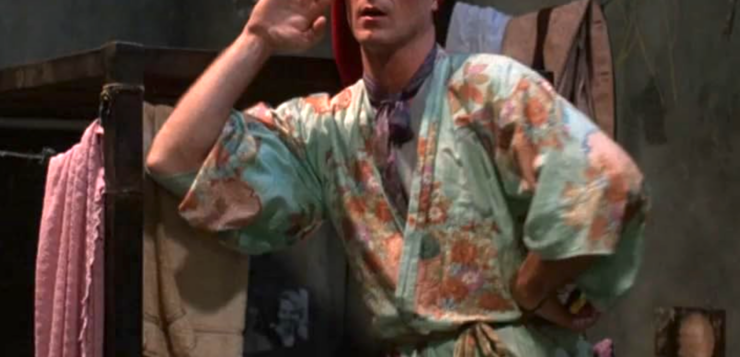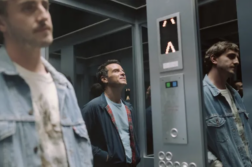HOW HAVE LGBT people been represented in Oscar-honored films to date, and might it have been otherwise? The first actor to win an Academy Award for playing a character who was indisputably gay was William Hurt, for the doomed (and morally inscrutable) Luis Molina in Hector Babenco’s Kiss of the Spider Woman, in 1985. To be sure, there had been queer-coded characters in Best Picture-winning films before that—Lawrence of Arabia and Midnight Cowboy spring to mind—but, with Hurt’s Spider Woman win, the Academy of Motion Picture Arts and Sciences betrayed a pattern of hostile prejudice toward LGBT people that would play itself out in the years to come.
That LGBT people in film are disproportionately represented as killers or as killed (or both) is not breaking news. Active and passive homophobia in Hollywood was sweepingly chronicled by Vito Russo in The Celluloid Closet and by subsequent film historians. Here my focus—and grievance—is with Oscar-winning films and roles after 1985 in which LGBT people perish or come to a bad end. Briefly stated, the past four decades form an era in which the major studios have finally acknowledged the existence of gay people even as they have persisted in punishing gay characters for daring to exist.
Since Kiss of the Spider Woman, fourteen more Oscars have been bestowed for roles or films in which explicitly queer lead characters die by suicide (four), gunshot wounds (three), beatings (two), AIDS (two), poisoning (one), lethal injection (one), and gender-affirming surgery (one), making the Academy a wax museum of cinematic LGBT deaths. If we were to assume that Oscar-winning films killed off cisgender and straight characters at a similar rate to queer ones, we would be sorely mistaken. Since the Spider Woman offered Molina her Kiss, 25 or more straight and cisgender characters have survived slavery, the Old West, World War II, the Holocaust, the Vietnam War, the Iraq War, homelessness, and Hannibal Lector in Academy Award-winning movies. Only thirteen straight characters have died in Oscar-winning roles or as leads in Best Picture winners since 1985—giving heterosexual and cisgender characters a three in four chance of survival and LGBT characters approximately the same odds of perishing before the credits roll.

That’s entertainment, so they say. Oscar-surviving, cinematically out LGBT people of the last four decades have included Queen Anne of England, Don Shirley (in Green Book), and Truman Capote, along with the gay youth Chiron in Moonlight (2016) and the bundle of stereotypes that Penelope Cruz portrayed in Woody Allen’s Vicky Cristina Barcelona (2008)—and that’s about it.
Adding insult to injury, the odds that a Best Actor playing a gay character will be straight and an Oscar winner playing a transgender character will be cis and opposite sex are 100 percent. Setting aside the then-closeted winners Jodie Foster and Kevin Spacey, the number of out queer actors who have won a Best Actor since 1985 is zero. While straight actors who take queer roles may appear to obstruct the development of LGBT careers at cinema’s highest tiers, readers will rejoice to learn that ostensibly heterosexual actors Stanley Tucci—lauded for multiple gay roles—and Benedict Cumberbatch—Oscar-nominated for two—seem to suffer no pangs of guilt for the gayface roles they accept. Tucci marshaled unnamed “gay men” who conveniently confirmed that he “did it the right way” when asked by the BBC how he responds to criticism for playing gay. Asked a parallel question by IndieWire about playing a gay role in Power of the Dog, Cumberbatch protested: “Is this a thing where our dance card has to be public? Do we have to explain all our private moments in our sexual history?” Well, no need to explain. Identity theft has been a grand tradition in Hollywood at least since the 1930s, when Warner Oland—born in Sweden—starred in sixteen films as the Asian detective Charlie Chan.
How did we get here? Stonewall stormed the closet in 1969, the American Psychiatric Association pulled heterosexuality from its pedestal (the Diagnostic and Statistical Manual) in 1973, and—notwithstanding David Bowie’s best efforts to exploit bisexuality as edgy and iconoclastic—queerness became almost banal in early 1980s popular culture. Movies released during Reagan’s first term might cast us as murderers (1980’s Cruising and Dressed to Kill), victims (1984’s Mike’s Murder), or both (1982’s Deathtrap). On the other hand, Victor/Victoria (1982) and Silkwood (1983) featured secondary or ensemble LGBT characters who were integral to the plot and better developed than the usual gay best friends. And a number of films, including Making Love, Personal Best, Partners (all from 1982), and—wait for it—Zorro the Gay Blade (1981), stumbled toward the possibility of LGBT characters as protagonists and even as heroes.
And yet, as many a screenwriter knows, midway through the story our hero faces imminent destruction and is robbed of all hope. Just so, in 1985, Rock Hudson died of AIDS, the FDA approved the first HIV test kit, Ryan White was barred from attending middle school, and, according to the CDC, more people were diagnosed with AIDS than in all preceding years combined. The parcel of cultural ground that we had gained in the early 1980s was lost to a kind of devastation that was so vast as to overwhelm any fragile gains we had made in the realm of popular culture. There were a few sympathetic portrayals of people with AIDS early on—Buddies (1983), Parting Glances (1986), Tongues Untied (1989), and Longtime Companion (1989)—all of them directed by gay men who fell ill themselves and were dead by 1996. The four directors—Bill Sherwood, Arthur J. Bressan Jr., Marlon Riggs, and Norman René—never got to make sequels depicting HIV survivors facing unexpected longevity, survivor guilt, or the growing LGBT acceptance of the 21st century (at least until the current backlash).
From the onset of HIV to today, Oscar-winning mainstream movies have continued to honor the tradition of homophobic narrative tropes that hark back to such mid-20th-century films as Rope (1948) and The Children’s Hour (1961). The depiction of doomed or murderous (or doomed and murderous) LGBT people this far into the 21st century, and the Academy’s acceptance of such films, can only be explained as a deliberate or unconscious embrace of anti-gay prejudice in the service of straight supremacy.
Framing gay identity as tethered to hiv/aids was perhaps understandable, however simplistic, in 1993. Andrew Beckett’s diagnosis drove the plot of Philadelphia, and HIV, along with glum perseverance, was his defining attribute. In the current century, conflating gay identity with hiv/aids is lazy at best, heartless at worst. Bohemian Rhapsody (2018) flaunted AIDS as the motive force behind Freddie Mercury’s 1985 Live Aid performance, even though his diagnosis did not come until two years after Live Aid’s final bow. This historical error did not disqualify Bohemian Rhapsody from a Best Picture nomination or bar Remi Malek, who portrayed a depressed and vocally fried Freddie Mercury, from winning the award for Best Actor. Mercury, if memory serves, was the queer genius who stole the show at Live Aid, had a three-octave vocal range, wrote more than half of Queen’s seventeen biggest hits, and looked devilishly clean-cut in a blue tuxedo beside opera diva Montserrat Caballé while filming the video for his contest-winning Olympics theme on a Mediterranean island, by torchlight, in 1987. His tragic fall can never eclipse his flash of life, yet Bohemian Rhapsody presented his life as a sad and irreversible slog toward death.
Somehow this portrayal seems reminiscent of 2002’s The Hours, when Virginia Woolf is asked why a certain character in Mrs Dalloway dies, and she solemnly replies that someone must die “in order that the rest of us should value life more.” This ghoulish platitude is found nowhere in Woolf’s work or in Michael Cunningham’s source novel, but it does express a certain kind of LGBT martyrdom that the Academy loves. For enacting The Hours’ central—but not only—queer human sacrifice, Nicole Kidman won the award for Best Actress.

Following The Hours’ success, Ang Lee won Best Director for Brokeback Mountain (2005), and Best Actor and Actress Awards were given for fatal LGBT roles in Monster (2003), Black Swan (2010), and Milk (2010) (though I concede that Sean Penn’s respectful and joyful portrayal of Harvey Milk leaves an afterimage so defiantly alive that it almost, for a moment, eclipses the horror of Milk’s murder). 2016’s Moonlight might have heralded a truce between the Academy and Our People. Chiron, the gay character, was still alive at the end of this Oscar-winning film, pensively alone but still harboring the possibility of a satisfying life. Also auspicious: Olivia Coleman earned the award for Best Actress for steering Queen Anne through The Favourite in 2018, and Mahershala Ali got a Best Supporting Actor that year for escaping Green Book with Don Shirley intact. On the other hand, the Best Actor wins of the leading—and bleeding—men of 2019’s Bohemian Rhapsody and 2022’s The Whale showed that being queer remains a terminal condition for films that get an Oscar nod.
Salvaging meaning from the Sargasso tangle of The Whale may best be accomplished by viewing this film as an anthropomorphized Moby Dick with the whale upstaged by a tidal sinkhole named Charlie, who pulls any possible suspense or interest into his inescapable undertow. Like the bisexual Nina in director Darren Aronofsky’s previous Black Swan, 2011’s Best Picture, Charlie masturbates in agony, is helpless before mental illness, dies by passive suicide, and—in a moment of dazzling vulgarity—ascends heavenward in beatific white light while dying. The bravest and most beautiful thing a queer person can do in Aronofsky’s world is to leave it, and the Academy agrees.
Going The Whale one better, 2021’s The Power of the Dog combined the gay murderer trope with the gay victim trope and fetched a 2022 Best Director Award for Jane Campion. If the wins of Bohemian Rhapsody, The Whale, and The Power of the Dog are any indication, the Academy’s taste for doomed gay characters continues undiminished into the 21st century. Straight writers and filmmakers aren’t entirely to blame for this; they’ve had their share of LGBT collaborators. The murderous gay narcissist of Dorian Gray, the dying pederast in Death in Venice, and the murderous bisexual bartender of Giovanni’s Room have been among the fictional avatars our finest writers have invented for us. A perfect emblem for this internalized homophobia may be the naked man—the corpse of the protagonist’s boyfriend— who sinks through a dark ocean at the beginning of Tom Ford’s A Single Man, adapted from Christopher Isherwood’s novel. Gay, dead, and—thanks to some determined camerawork— devoid of sex organs, this slowly sinking man occupies the condition our culture would most like to see us in, if we must be seen at all. That LGBT writers and filmmakers failed for so long to imagine a better story for ourselves is evidence of how the families, schools, churches, neighborhoods, and cinemas we grew up in destroyed even our ability to dream.
The second half of the two-part question with which this essay began—Might it have been otherwise?—can no doubt be answered in a number of ways. Television—longstanding enemy of box office receipts—offers a myriad of possibilities. Week by week, on Netflix, Prime, Max, and other streamers, we see LGBT royals, commoners, explorers, students, teachers, performers, pirates, werewolves, superheroes, and mortals who fall in love, face adversity, support each other, enjoy sex, set out on adventures, and manage not to kill each other or themselves. While the unhappy LGBT past reeks to high heaven at the Oscars, LGBT futures are happily imagined on the small screen. Red, White, and Royal Blue, Love Victor, Heartstopper, Pose, It’s a Sin, Dear White People, Our Flag Means Death, Wolf Pack, Wreck, and even the animated Moon Girl and Devil Dinosaur and Dead End: Paranormal Park speed beyond toleration to welcome sexual and gender diversity as… human. Prestige cinema has much to learn from television.
If Colman Domingo had won Best Actor for the title role in Rustin, we might have gotten another answer to this essay’s opening question. Bayard Rustin’s biopic acknowledges the shadowy paths LGBT people have walked to participate and survive; its final moments show the pivotal Civil Rights leader helping to pick up trash on the National Mall while the people he worked with to plan the 1963 March on Washington would later meet with President Kennedy. But Rustin is also a story of triumph and survival. Domingo’s radiant vitality as Rustin lights up the screen, and in the film’s conclusion he’s alive and smiling. For an LGBT role to have a pulse and a smile at its dénouement and win its actor an Oscar could have been a turning point for the Academy. Instead, the golden swordman remains mired in toxic conservatism, and I’ll be chilling with Netflix on Oscar night 2025.
Andrew White, based in Philadelphia, works in libraries, museums, and sometimes at the zoo. Now and then he publishes a short story.




